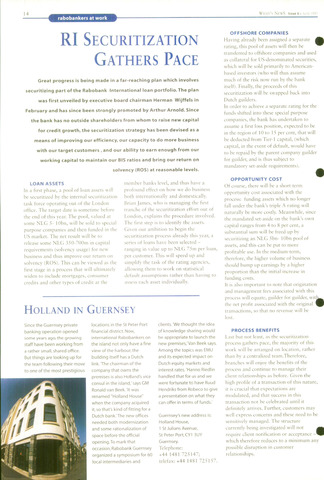RI Securitization
Gathers Pace
Holland in Guernsey
+44 1481 725147;
telefax: +44 1481 725157.
14
rabobankers at work
WHAT's NewS Issue 6 June 1997
Great progress is being made in a far-reaching plan which involves
securitizing part of the Rabobank International loan portfolio.The plan
was first unveiled by executive board chairman Herman Wijffels in
February and has since been strongly promoted by Arthur Arnold. Since
the bank has no outside shareholders from whom to raise new capital
for credit growth, the securitization strategy has been devised as a
means of improving our efficiency, our capacity to do more business
with our target customers and our ability to earn enough from our
working capital to maintain our BIS ratios and bring our return on
solvency (ROS) at reasonable levels.
LOAN ASSETS
In a first phase, a pool of loan assets will
be securitized by the internal securitization
task force operating out of the London
office. The target date is sometime before
the end of this year. The pool, valued at
some NLG 5- lObn, will be sold to special
purpose companies and then funded in the
US market. The net result will be to
release some NLG 350-700m in capital
requivements (solvency usage) for new
business and thus improve our return on
solvency (ROS). This can be viewed as the
first stage in a process that will ultimately
widen to include mortgages, consumer
credits and other types of credit at the
member banks level, and thus have a
profound effect on how we do business
both internationally and domestically.
Brian James, who is managing the first
tranche of the securitization effort out of
London, explains the procedure involved.
The first step is to identify the assets.
Given our ambition to begin the
securitization process already this year, a
series of loans have been selected -
ranging in value up to NLG 75m per loan,
per customer. This will speed up and
simplify the task of the rating agencies,
allowing them to work on statistical
default assumptions rather than having to
assess each asset individually.
OFFSHORE COMPANIES
Having already been assigned a separate
rating, this pool of assets will then be
transferred to offshore companies and used
as collateral for US-denominated securities,
which will be sold primarily to American-
based investors (who will thus assume
much of the risk now run by the bank
itself). Finally, the proceeds of this
securitization will be swapped back into
Dutch guilders.
In order to achieve a separate rating for the
funds shifted into these special purpose
companies, the bank has undertaken to
assume a first loss position, expected to be
in the region of 10 to 15 per cent, that will
be deducted from Tier-1 capital, (which
capital, in the event of default, would have
to be repaid by the parent company guilder
for guilder, and is thus subject to
mandatory set-aside requirements).
OPPORTUNITY COST
Of course, there will be a short-term
opportunity cost associated with the
process: funding assets which no longer
fall under the bank's triple A rating will
naturally be more costly. Meanwhile, since
the mandated set-aside on the bank's own
capital ranges from 4 to 8 per cent, a
substantial sum will be freed up by
securitizing an NLG 5bn- lObn pool of
assets, and this can be put to more
profitable use. In the medium-term,
therefore, the higher volume of business
should bump up earnings by a higher
proportion than the initial increase in
funding costs.
It is also important to note that origination
and management fees associated with this
process will equate, guilder for guilder, wit'
the net profit associated with the original
transactions, so that no revenue will be
lost.
PROCESS BENEFITS
Last but not least, as the securitization
process gathers pace, the majority of this
work will be arranged on location, rather
than by a centralized team.Therefore,
branches will enjoy the benefits of the
process and continue to manage their
cliënt relationships as before. Given the
high profile of a transaction of this nature,
it is crucial that expectations are
modulated, and that success in this
transaction not be celebrated until it
definitely arrivés. Further, customers may
well express concerns and these need to be
sensitively managed. The structure
currently being investigated will not
require cliënt notification or acceptance -
which therefore reduces to a minimum any
possible disruption in customer
relationships.
Since the Guernsey private
banking operation opened
some years ago.the growing
staff have been working from
a rather small.shared office.
But things are looking up for
the team following their move
to one of the most prestigious
locations in the St Peter Port
financial district. Now,
international Rabobankers on
the island not only have a fine
view of the harbour.the
building itself has a Dutch
link. 'The chairman of the
company that owns the
premises is also Holland's vice
consul in the island,' says GM
Ronald van Beek. 'It was
renamed "Holland House"
when the company acquired
it, so that's kind of fitting for a
Dutch bank/The new offices
needed both modernization
and some rationalization of
space before the official
opening.To mark that
occasion, Rabobank Guernsey
organized a symposium for 60
local intermediaries and
clients. 'We thought the idea
of knowledge sharing would
be appropriate to launch the
new premises,'Van Beek says.
Among the topics was EMU
and its expected impact on
Dutch equity markets and
interest rates.'Hanno Riedlin
handled that for us and we
were fortunate to have Ruud
Hendriks from Robeco to give
a presentation on what they
can offer in terms of funds.'
Guernsey's new address is:
Holland House,
1 StJulians Avenue,
St Peter Port, CY1 3UY
Guernsey.
Telephone:

